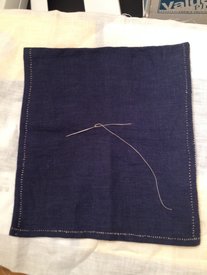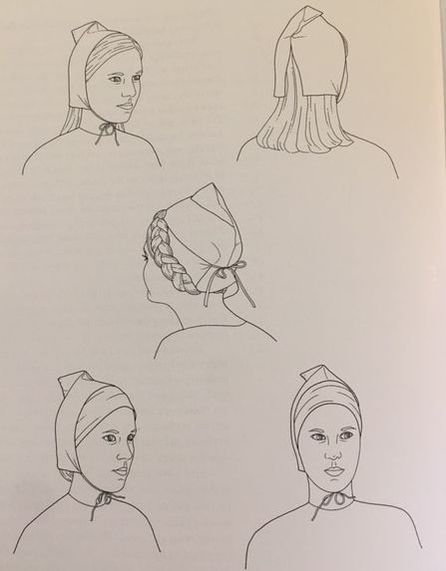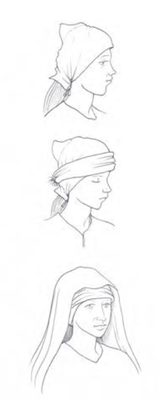 Small linen cap I made several years ago.
Small linen cap I made several years ago. , If you have stopped by here before, you likely know that I try to leave the Woulda/Coulda/Shoulda’s out of my work. Those phrases tend to lead down long and winding roads into fantasyland. The other thing I strongly dislike is absolutes. The idea that something was always one way is rather off-putting (especially when it is something readily disproven). There is this balance that must be achieved when looking at what bits of evidence we have, while still applying some creativity to sort things out into a reasonable approximation of what is historically plausible.
With that in mind, I want to talk a little about some research I am doing on women’s caps from the Viking Age. There is evidence of an assortment of interesting headcovering possibilities, including the caps, as well as some narrow cloth bands, small scarves and veils. I think that, over all, the caps seem to be the most common item I see among reenactors, and are one of the first that I personally used. I will eventually expand on this post, with full citations and the like, but I wanted to toss what is going through my head out there now.
To start, I will define a Viking age cap as a small item, usually square, though the top might be shaped with a dart, that typically has ties attached. I have found mention 21 such caps/possible caps in my research. There are additional small fragments, especially from Dublin, and one from London, that are thought to possibly be from caps, but I have left those items out for the moment, as I am trying to look few specific details that can help provide a better understanding of these items. The items for which I compiled data range from the 9th-11th century (with 2 being listed as uncertain), with most of them falling into the 9th-10th century range.
Textiles
All of these items have one thing in common, and that is that the cloth of which they are constructed is a light weight and very fine tabby. Most of them are even described as having deliberate space left in the warp and weft, giving them a gauzy appearance. They are delicate and most have some level of transparency. All of the extant items are wool or silk, though at least one of the author’s who have studied these items thinks that linen was also a possibility, and that the fiber did not survive in the ground.
Fine, gauzy cloth textiles, many of which have been attributed to women’s headcoverings, have been found in a number of graves and sites, and across a range of locations, including York, Hedeby, Oslo, Hørning, London, Lincoln, Kaupang, Önsvala in Skåne, Oseberg and possibly Birka. Each of the caps meets the criteria of being a very fine fabric. Unfortunately, most textiles in graves are preserved by contact with metal objects, and metal near or on the head is not always common. It is entirely possible that there were indeed caps of heavier cloth (there is one from Finland and one from the Netherlands that have some similarity to these items that were not of fine cloth), but I think there are enough caps and cloth remaining to believe that at least for certain circumstances, that there might have been a preference for fine textiles for this accessory.
A further complication concerning these caps is that most of the items that are actually identifiable as headcoverings do not come from graves at all. That takes them out of context and while there is an assumption that they are indeed women’s headcoverings, they also could have belonged to children (or both women and children).
Width
Another similarity in all of these items is size. The finished width of them is very narrow. Of the 20 that I looked at, 14 of them have a definite width, or at least an estimated width applied to them by the researchers. They range from 15cm to 18cm wide, with an average of 16.7cm (6.6 inches). That is exceedingly narrow (far narrower than many reenactors make them and far more narrow than my own first attempts at recreating these items). Simply put, these will cover only the back of the head if worn by an adult.
Darts
Of the 20 items, 10 had traces of having had a dart, following the curve of the back of the head, sewn into them. 6 were too fragmented to tell. One of the caps from York had the point created by the dart stitched down to the side.
Back seam
While many of the caps appeared to have a back seam that went the length of the cap, one from Lincoln and two from Dublin were open below the bottom of the dart.
Patches
5 of the caps had patches applied. Interestingly enough, one of them had a patch applied on the inside of the cap (which would leave the damaged area showing). One had patches applied near where the ties were attached, presumably for additional strength. One also showed signs of darning.
Ties
I think there is a reenactorism that has developed around the ties on the caps. I have heard statements to the effect that caps have too have the ties set up into the cap (an inch or two, or more, from the bottom corner), as the example from York shows. I have even heard that caps with ties at the bottom corners were only for small children. I think that is odd given that we simply do not have the grave evidence to state exactly who wore these caps. Further, 7 of the 20 examples that I used for this research have the bottom corner of the cap stretched out of alignment, as if there had been a tie there at one point. Only 3 of the 20 show evidence of a tie set further up into the cap, and 10 of them are too fragmented or just do not have evidence of ties.
Beyond the location of the ties, it is very hard to say where or how they were tied. Most reenactors prefer to tie them behind the head or under the hair, but one cannot discount them being tied under the chin like a later coif either. (The tie would be well hidden under certain styles of veil from that time period as well, and there is an image from Kiev that shows such a headcovering, tied under the chin, as well.)
My thoughts
I think that these caps (and possibly the scarves as well) were a base layer for additional headcoverings. A cap tied in place (whether under the chin or back under the hair) makes for easy of pinning a veil in place and can help to keep hair out of the face or out of the way of tasks. The manner in which a few of these are patched (with little care for a visible hole, in the case of one patched on the inside, or in case of a visible patch for reinforcement on another one) makes it seem as though the appearance of the item itself was not terribly relevant (even in the case of a costly import such as silk).
I think it possible that the cap was a common item worn daily, and perhaps a veil was donned on top of it if one was leaving home or receiving guests. I do not consider the cap alone to be “outerwear” for harsh outdoor climates as the size of these items do not allow for much protection from the sun and the diaphanous nature of the cloth itself does little to provide warmth. I would not necessarily consider it “formal wear” at this point either. I believe that, especially later in the Viking Age, that women were using veils as a symbol of status and that these caps might well have been worn under those. In fact, a small wool gauze veil or scarf does a great deal to make a veil less likely to slip around on slick hair.
The dart itself is fascinating to me. I find that a soft cap of wool gauze with a dart) lays exceptionally well under a veil (the peak of the dart naturally folds over, without leaving much of a point at the back of the veil. I linen cap with no dart, tends to leave a more visible point under the veil. I definitely plan to experiment more with a variety of options.
I think that some details about the caps varied greatly, such as whether there was a dart (though I lean towards more having had them historically than not) or the location of the ties. Those with an open back bear some similarity to the proposed uses of the scarves, in that one could wear the rectangle of cloth and tie it on back under the hair. This type can slide further forward on the head than a cap with a back could. It could be regional or just personal preferences when it comes down to it. There are so many variables.
Heckett's work with the headcoverings from Dublin includes diagrams that show ways one can wear the caps, but I think that a more recent item in an article by Penelope Walton Rogers gives a more interesting view (both can be seen below).
References (Incomplete)
- Krag, A. H. Finely Woven Textiles from the Danish Viking Age.
- Heckett, E. W. (1990). Some silk and wool head-coverings from Viking Dublin: uses and origins--an enquiry. NESAT 3.
- Heckett, E. W. (2002). Irish Viking Age silks and their place in Hiberno- Norse society. Textile Society of America Symposium Proceedings.
- Heckett, E. W. (2003). Viking Age Headcoverings from Dublin.
- MacGregor, Arthur. (1982) Anglo-Scandinavian Finds from Lloyds Bank, Pavement, and Other Sites.
- Walton Rogers, P. (1989). Textiles, Cordage and Raw Fibre from 16-22 Coppergate.
- Walton Rogers, P. (1997). Textile Production at 16 – 22 Coppergate The Archaeology of York. The Archaeology of York - The Small Finds, 17, 1687–1844.
- Walton Rogers, P. Cloth, clothing and Anglo-Saxon women. In A Stitch in Time Essays in Honour of Lise Bender Jørgensen.


 RSS Feed
RSS Feed